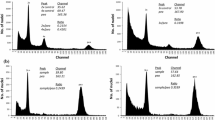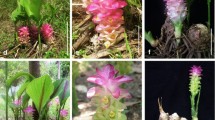Abstract
The African horned cucumber (Cucumis metuliferus Naud.; 2x = 2n = 24) contains genes that can confer resistance to many important cucumber (C. sativus L.; 2x = 2n = 14) pests [e.g., root-knotnematode, Meloidogyne incognita (Kofoid & White) Chitwood]. Cucumber is highly susceptible to this root-knot nematode species, and a recent screening of C. sativus accessions in the U.S. National Plant Germplasm collection did not identify sources of resistance. Thus,autotetraploids of Cucumis sativus and C. metuliferus were created to recover fertile resistant interspecific progeny. Autotetraploids were obtained at the highest rate when seeds were immersed in 0.5% colchicine for a period of 6 to 8 hrs. Treatment durations less than 6 hrs produced few tetraploids, and durations of 10 hrs or more were lethal to seeds or developing seedlings. Crosses between C. sativus and C. metuliferus were made using diploid and tetraploid lines in all possible combinations, including reciprocals. Fruit development occurred in crosses when diploid and tetraploid C. sativus were used as the female parent. However, seeds developed only in fruit of C. sativus (4n) ×C. metuliferus (2n) crossings. Seeds from these crosses, however,were flat and not viable. No fruit development occurred in crosses whereC. metuliferus was used as the female parent.
Similar content being viewed by others
References
Chen, J.F., J.W. Adelberg, J.E. Staub, H.T. Skorupska & B.B. Rhodes, 1998. A new synthetic amphidiploid in Cucumis from a C. sativus × C. hystrix F1 interspecific hybrid. In: J. Mc-Creight (Ed.), Cucurbitaceae’ 98 - Evaluation and Enhancement of Cucurbit Germplasm. ASHS Press, Alexandria, Va.
Chen, J.F. & J. Adelberg, 2000. Interspecific hybridization in Cucumis-progress, problems, and perspectives. HortScience 35: 11–15.
Dane, F., 1991. Cytogenetics of the genus Cucumis. In: T. Tsuchiya & P.K. Gupta (Eds.), Chromosome Engineering in Plants: Genetics, Breeding, and Evolution, Part B. Elsevier Science Publishing Company, Inc., New York.
Deakin, J.R., G.W. Bohn & T.W. Whitaker, 1971. Interspecific hybridization in Cucumis. Econ Bot 25: 195–211.
den Nijs, A.P.M. & J.B.M. Custers, 1990. Introducing resistances into cucumbers by interspecific hybridization. In: D.M. Bates, R.W. Robinson & C. Jeffrey (Eds.), Biology and Utilization of the Cucurbitaceae. Cornell Univ. Press, Ithaca, NY.
Fassuliotis, G., 1977. Self-fertilization of Cucumis metuliferus Naud. and its cross-compatibility with C. melo L. J Amer Soc Hort Sci 102: 336–339.
Fassuliotis, G., 1979. Plant breeding for root-knot nematode resistance. In: J.D. Sasser & C.C. Carter (Eds.), Root-Knot Nematodes (Meloidogyne species): Systematics, Biology and Control. Academic press, New York.
Fassuliotis, G. & B.V. Nelson, 1988. Interspecific hybrids of Cucumis metuliferus × C. anguria obtained through embryo culture and somatic embryogenesis. Euphytica 37: 53–60.
Franken, J., J.B.M. Custers & R.J. Bino, 1988. Effects of temperature on pollen tube growth and fruit set in reciprocal crosses between Cucumis sativus and C. metuliferus. Plant Breed 100: 150–153.
Hadley, H.H. & S.J. Openshaw, 1980. Interspecific and intergeneric hybridization. In: W.R. Fehr & H.H. Hadley (Eds.), Hybridization of crop plants. American Society of Agronomy, Madison, Wis.
Kubicki, B., 1962. Polyploidy in muskmelons (Cucumis melo L.) and cucumbers (Cucumis sativus L.). Genetica Polonica 3: 161–179.
Norton, J.D. & D.M. Granberry, 1980. Characteristics of progeny from an interspecific cross of Cucumis melo with Cucumis metuliferus. J Amer Soc Hort Sci 105: 174–180.
Robinson, R.W. & D.S. Decker-Walters, 1997. Cucurbits. CAB International, Wallingford, UK.
Sass, J.E., 1958. Botanical Microtechnique. Iowa State College Press, Ames.
Sasser, J.N. & M.F. Kirby, 1979. Crop cultivars resistant to rootknot nematodes, Meloidogyne species. Cooperative Publication of North Carolina State University Department of Plant Pathology and United States Agency for International Development, North Carolina State University Graphics, Raleigh, N.C.
Smith, L., 1947. The acetocarmine smear technique. Stain Technol 22: 17–31.
Smith, O.S. & R.L. Lower, 1973. Effects of induced polyploidy in cucumbers. J Amer Soc Hort Sci 98: 118–120.
Staub, J.E., L.D. Knerr & D.J. Holder, 1992. Phylogenetic relationships among several African Cucumis species. Can J Bot 70: 509–517.
Stoskopf, N.C., D.T. Tomes & B.R. Christie, 1993. Plant Breeding: Theory and Practice. Westview Press, Inc., Oxford, UK.
Tatioglu, T., 1992, Cucumber Cucumis sativus L. In: G. Kalloo & B.O. Bergh (Eds.), Genetic Improvement of Vegetable Crops. Pergamon Press, Oxford, U.K.
Walters, S.A., T.C. Wehner & K.R. Barker, 1993. Root-knot nematode resistance in cucumber and horned cucumber. HortScience 28: 151–154.
Wehner, T.C., S.A. Walters & K.R. Barker, 1991. Resistance to rootknot nematode in cucumber and horned cucumber. J Nematol 23: 611–614.
Whitaker, T.W. & G.N. Davis, 1962. Cucurbits. Leonard Hill, London, 250 pp.
Author information
Authors and Affiliations
Rights and permissions
About this article
Cite this article
Walters, S.A., Wehner, T.C. Incompatibility in diploid and tetraploid crosses of Cucumis sativus and Cucumis metuliferus . Euphytica 128, 371–374 (2002). https://doi.org/10.1023/A:1021212815590
Issue Date:
DOI: https://doi.org/10.1023/A:1021212815590




